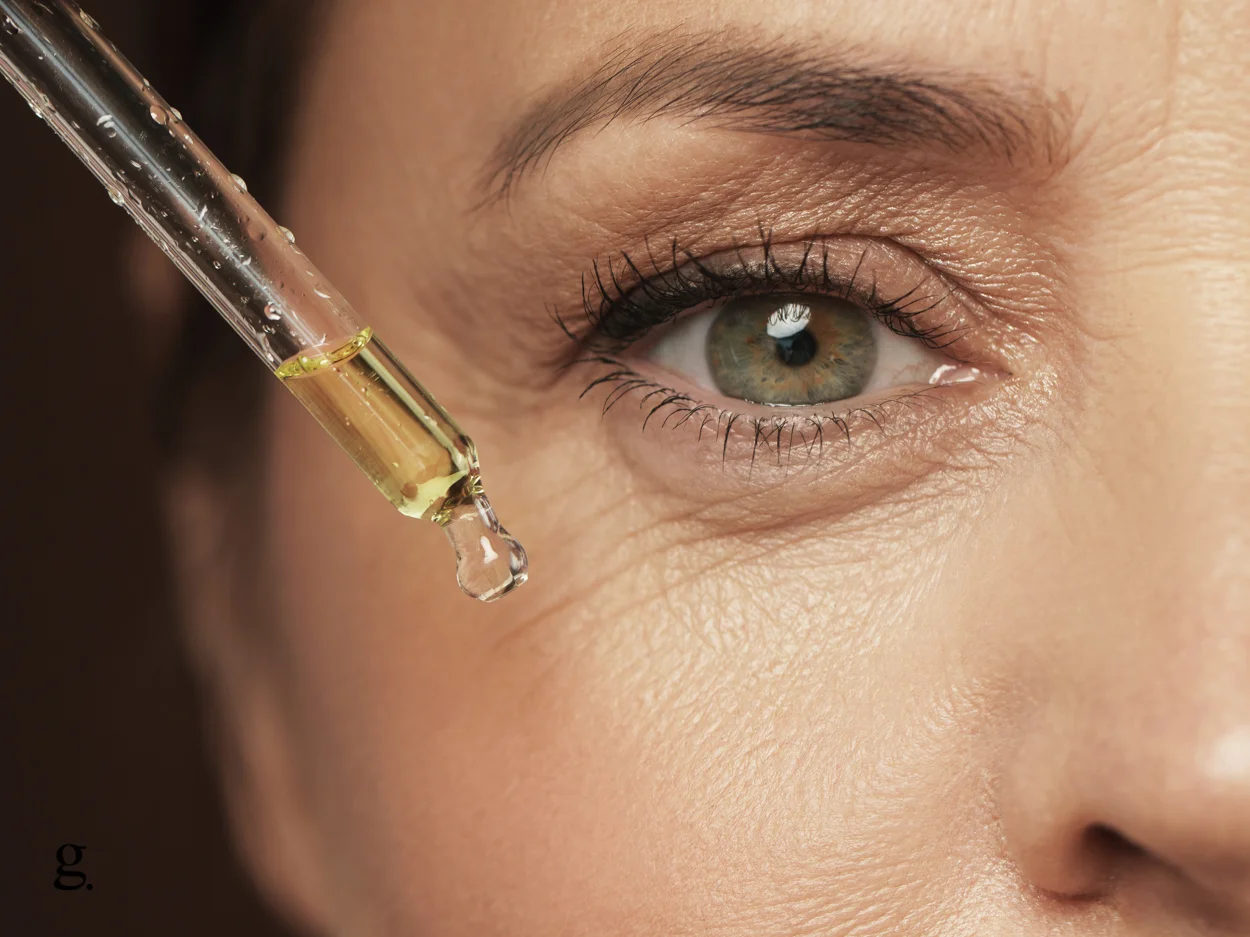It’s that thin, crinkly, and papery texture that can make the skin appear a bit like crepe paper. While it’s a natural part of the aging process, it doesn’t mean there aren’t ways to help reduce the appearance of crepey skin
Improving the appearance of crepey skin is doable with a little dedication and the right approach. Here are some of the best ways to give that crinkly skin a run for its money and reveal a smoother, more youthful-looking complexion.
1. Moisturize, Moisturize, Moisturize
Moisturizing is an essential step in any skincare routine, especially when dealing with crepey skin. A good moisturizer can help hydrate the skin, improve its texture, and reduce the appearance of fine lines and wrinkles. Look for products that contain ingredients like hyaluronic acid, glycerin, or ceramides, which help attract and lock in moisture. Hyaluronic acid is particularly effective as it can hold up to 1000 times its weight in water, making it an excellent ingredient for dehydrated skin.
Glycerin is another excellent humectant that helps draw water into the skin and hydrate it. Ceramides are lipids that form the skin’s barrier, helping to lock in moisture and protect against external aggressors. Incorporating a moisturizer into your daily routine can help improve the overall appearance of crepey skin.
2. Exfoliate Gently
Exfoliating is a crucial step in any skincare routine as it helps remove dead skin cells and promote cell turnover. This, in turn, can reveal fresher, smoother, and more radiant skin. However, when dealing with crepey skin, it’s essential to choose gentle exfoliants that won’t irritate the skin further.
Chemical exfoliants like alpha-hydroxy acids (AHAs) or beta-hydroxy acids (BHAs) are a great option as they work to dissolve the bonds between dead skin cells without the need for physical abrasion. AHAs like glycolic acid and lactic acid can help improve the texture and tone of the skin, while BHAs like salicylic acid can help unclog pores and reduce inflammation. However, it’s crucial not to over-exfoliate, as this can damage the skin’s natural barrier and lead to further problems.
3. Use Retinoids
Retinoids are a class of vitamin A derivatives that are highly effective at treating crepey skin. They work by stimulating collagen production and improving skin elasticity, resulting in firmer, smoother skin. Retinoids are also effective at reducing the appearance of fine lines, wrinkles, and dark spots.
However, retinoids can be irritating, so it’s important to start with a low concentration and gradually work your way up. It’s also essential to wear sunscreen during the day as retinoids can make the skin more sensitive to the sun.
4. Prioritize Sun Protection
Sun damage is one of the leading causes of crepey skin, so it’s crucial to protect your skin from the sun’s harmful rays. Apply a broad-spectrum sunscreen with at least SPF 30 daily, even when it’s cloudy.
Look for sunscreens that contain physical blockers like zinc oxide or titanium dioxide, as these ingredients offer broad-spectrum protection against UVA and UVB rays. Don’t forget to reapply every two hours or after swimming or sweating.
5. Consider Professional Treatments
Professional treatments like chemical peels, microneedling, laser resurfacing, and radiofrequency treatments can be effective at improving the appearance of crepey skin. Chemical peels work by removing the outer layer of dead skin cells, while microneedling creates micro-injuries that stimulate collagen production.
Laser resurfacing can help reduce fine lines and wrinkles, while radiofrequency treatments can tighten the skin and promote collagen production. However, these treatments can be expensive and may require downtime, so it’s essential to consult with a dermatologist or skincare professional to determine the best treatment for your specific needs.
6. Stay Hydrated
Drinking enough water throughout the day is crucial for overall skin health. Adequate hydration helps maintain skin elasticity and plumpness, which can minimize the appearance of crepey skin.
7. Eat a Balanced Diet
A balanced diet rich in vitamins, minerals, antioxidants, and healthy fats can help support overall skin health and minimize the appearance of crepey skin. Foods high in vitamins A, C, and E, as well as omega-3 fatty acids, can help promote collagen production, protect against free radicals, and keep the skin hydrated.
Some examples of foods that are good for the skin include leafy greens, berries, citrus fruits, fatty fish, nuts, and seeds. Incorporating these foods into your diet can help improve the health of your skin from the inside out.
Can Crepey Skin Be Reversed?
Crepey skin develops as a result of various factors. While you can improve its appearance and minimize its prominence, it’s not entirely possible to reverse crepey skin due to the complex, interconnected nature of these factors.
The main causes of crepey skin
Crepey skin can be a bit of a party crasher, but understanding the main causes behind it can help you tackle the issue head-on. Some of these causes are inevitable, while others can be controlled to some extent. Let’s break down the top culprits behind crepey skin, so you know what to keep an eye out for.
Aging
As mentioned earlier, aging is the primary cause of crepey skin. With age, the body’s production of collagen, elastin, and hyaluronic acid slows down. This decrease in essential skin components leads to reduced elasticity, firmness, and moisture retention, resulting in thinner and more fragile skin that takes on a crepe-like texture.
Prolonged Sun Damage
UV radiation from the sun damages the skin’s structural proteins, such as collagen and elastin. Over time, this damage accumulates, leading to premature aging and exacerbating the appearance of crepey skin. Remember, prevention is key! Always wear sunscreen with at least SPF 30, and opt for protective clothing and accessories like wide-brimmed hats and sunglasses.
Smoking
Smoking wreaks havoc on the skin in various ways. In addition to reducing blood flow and depriving the skin of oxygen and nutrients, the repetitive facial expressions associated with smoking, such as pursing the lips, can exacerbate the formation of wrinkles and crepey skin.
Prolonged Malnutrition
A diet lacking essential nutrients, antioxidants, and healthy fats can take a toll on your skin. To maintain skin health, it’s important to consume a balanced diet rich in vitamins A, C, and E, as well as omega-3 fatty acids. These nutrients help support collagen production and protect the skin from oxidative stress.
Extreme Weight Loss
When you lose weight rapidly, the skin may not have enough time to contract and adjust to your new body shape. This can result in sagging and crepey skin, particularly in areas where fat loss is most noticeable, such as the arms, abdomen, and thighs. Aim for a gradual and steady weight loss to give your skin time to adapt.
Dehydration
Adequate hydration is essential for maintaining skin health. When your skin is dehydrated, it becomes more susceptible to dryness, fine lines, and that dreaded crepey texture. Ensure you drink plenty of water throughout the day and use moisturizing products to keep your skin hydrated and supple.
Hormonal Changes
Hormonal fluctuations, particularly during menopause, can contribute to crepey skin. Decreased estrogen levels during menopause can lead to reduced collagen production and skin elasticity. It’s essential to consult with a healthcare professional to discuss potential treatments or therapies that may help alleviate these changes.
Understanding the causes of crepey skin is the first step in addressing the issue. By making conscious lifestyle choices, prioritizing proper skincare, and staying aware of potential triggers, you can work towards minimizing the appearance of crepey skin and maintaining your skin’s youthful resilience.
Conclusion
If you’re unhappy with the appearance of your crepey skin, then don’t despair – while it typically cannot be 100% reversed (especially when it is age-related), there are loads of different things you can do to improve it and give yourself a more youthful overall appearance.
We recommend you look into using topical vitamin C, retinol, peptides, or getting microneedling or laser skin renewal treatment(s) can all help to plump up your skin and reduce the appearance of tired and lifeless crepey skin.

